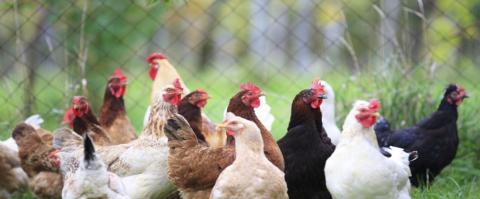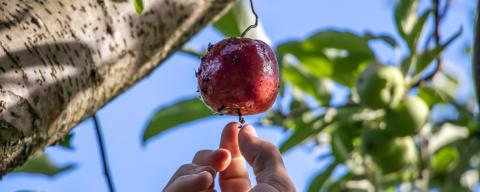Livestock Biosecurity Reminder—Protecting Your Flock from Avian Influenza

Highly pathogenic H5 avian influenza (HPAI) has recently been discovered in wild birds in New Hampshire and was recently discovered in small poultry flocks in Maine. Are you practicing good biosecurity to protect your flock? Whether you have a small backyard flock or are a large commercial poultry producer, we recommend you take the time to review your biosecurity practices.
Biosecurity Resources to Help Cover Your Bases
-
USDA APHIS - Defend the Flock Program
-
UNH Extension - Poultry Health and Management for the Small Flock
What should you do if you suspect HPAI?
In addition to practicing good biosecurity, all bird owners should prevent contact between their birds and wild birds and report sick birds or unusual bird deaths to State/Federal officials, either through the state veterinarian or through APHIS’ toll-free number at 1-866-536-7593.
-
NH Department of Agriculture, Markets, and Food Division of Animal Industry - find our state veterinarian contact here and more information about avian influenza
-
If you’re not sure what to look for, here is some additional information about HPAI and potential symptoms. Avian Influenza can look like a lot of other diseases, this is why good biosecurity and testing are so important.
-
APHIS is urging producers to bring birds indoors, when possible, to prevent exposure to wild birds. Utilizing fencing and avoiding free-ranging poultry helps!
For Commercial Poultry Producers
-
The Animal Health Protection Act authorizes APHIS to provide indemnity payments to producers for birds and eggs that must be depopulated during a disease response. APHIS also provides compensation for disposal activities and virus elimination activities.
Currently, according to the U.S. Center for Disease Control and Prevention the recent HPAI detection does not present an immediate public health concern. No human cases of these avian influenza viruses have been detected in the United States. As a reminder, the proper handling and cooking of poultry and eggs to an internal temperature of 165 ˚F kills bacteria and viruses.
Above information was adopted from USDA APHIS February 19, 2022 press release
Extension Services & Tools That Help NH Farmers Grow
Newsletters: Choose from our many newsletters for production agriculture
Receive Pest Text Alerts - Text UNHIPM to (866) 645-7010

